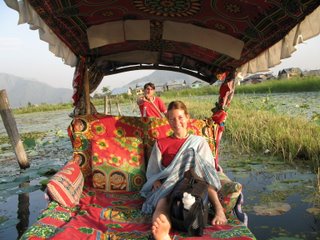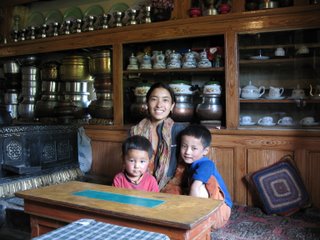One of our loyal followers (you know who you are), has asked some questions about travel basics + ethics in developing countries. I am by no means an expert on these subjects, but I'll just note my own experiences from travel to several countries each in Latin America, Europe + Asia. As this has become an even greater concern + passion of mine on this trip, and something I will continue to explore here, I'll try to address them in this public forum -
Where do you eat?Pretty much all my travel has been on a budget. Even when I was steadily employed and making a decent salary, I chose to do this primarily because I felt less insulated from the country I was visiting. Kind of a "when in Rome do as the Romans do" philosophy. So then, as now, we mainly eat in local restaurants (here they call them dhabas). Not only is it dirt cheap, but it's an interesting experience. Yes, cleanliness may be an issue, but there is really no assurance that the kitchens of "nice" restaurants (even at home) are any more sanitary. Just consider the bonus that you're building up your immunity :) Another thing to note is that people WILL stare, sometimes everyone in the place, but just smile and ignore them the best you can. It's probably just because you're eating with your left hand, which they only use for more unsavory purposes, but do you really care?! We do break down and eat in "Western" restaurants every couple of weeks when we're in a town with that option. The occasional veggie burger + fries or banana-nutella pancake will taste all that much better in moderation, no matter how inferior the quality.
What do you eat?We've both been veg for several years and neither one of us could choke down meat even if it meant refusing polite hospitality. Many third world countries, especially the poorer ones, subsist on some kind of legume and starch, fortunately for us, so in most cases it's not a problem. I'm pretty religious about keeping the grease/fat intake low, and sometimes that's not possible as deep-frying is a cheap + fast method of cooking, but you do what you can. We always try and keep a balanced diet with fresh fruit + veggies and protein too. Here, as in many other countries I've visited, eggs + bread are pretty widely available for breakfast, and if you go to the markets it's cheap + easy to buy fresh fruit, curd/yogurt + honey for a healthier alternative. Lunch on-the-go is usually fruit, and in Latin America it was very common to buy bags of pre-cut fruit for about 5-10 cents each so you could snack throughout the day as you got hungry. Many other quick snacks I've enjoyed include steamed corn, samosas, grilled bananas with coconut milk, cheese, noodles + beans. Street stalls ABOUND for this kind of thing, so just pick one that's busy and chances are you'll be rewarded with something tasty that won't get you sick. Dinner is most always some combination of legume and vegetable served with rice and/or bread. There ARE times when, being a fairly picky eater, I just can't find anything I think I can stomach, so in case of emergency I keep nuts or dried fruit on hand.
Where do you sleep?At 35 (well, even at 28) I consider myself far too old to do the dorm-bed thing. You WILL pay a premium as a single traveler (around 30%) vs. getting a double room, but in the third world - What's a dollar! I've found that in much of my (third world) travel it's cost me around $2-6 per person for a room. What you get for that price is highly variable so you have to look at a few before you accept. If you've got a bit more cash you get quite an upgrade in the $6-10 p/p range. In the past I've always used Lonely Planet for guidance, but lately have been dissatisfied with their change of focus, so have been turning to both Footprint + Moon Handbooks as good alternatives, as well as asking other traveler's. My budget digs have ranged from ones with hand-stenciled walls, writing desk + views to others where I've later discovered there were so many roaches I had to sleep on top of the covers with the lights on :( Most have been somewhere in between. We typically opt to save a couple bucks and get rooms with shared bath because really, how often are you in there? And after a while those extra dollars add up on a long trip. On this trip we just splurged on a Raj-era deluxe houseboat on a lake that only cost a whopping $7/night each including meals. Not too shabby, eh?!
What do you shop for?My primary shopping always seems to be for food, especially fruit. The stuff you get out here, because it's both in season + local tends to be some of THE best I've ever had in my life! Other than that, I always look for unique items that don't appear in every tourist-oriented shop. Some things I've bought in the past that I especially treasure are a necklace from the wife of a Shaman in the Ecuadorian Amazon made out of local seed pods and a fabric wrap that women wore specific to only that one village in Guatemala.
How do you feel about traveling in an area teetering on the edge of famine?There are fairly obvious pros + cons to this. I personally would tend to say "go"! Seeing something so radically different from our own consumerist culture will change you profoundly. Even seeing western consumerism translated and transferred halfway around the globe will change your views, and most likely actions. I believe that the more foreign + more challenging the trip, the more you stand to gain from it. I know lots of people have ZERO desire to take a trip like this. Sure, everyone needs a break and coming to the third world is not necessarily "relaxing". Some destinations CAN offer you both though. I've witnessed some pretty nauseating human suffering during my travels, but it's been mainly with specific individuals, not a people as a whole. I'd suggest not to bite off more than you can handle without becoming an emotional wreck to start. Do your research before-hand and find out if there are places you can volunteer, even for a day, or give money to an aid program (
Plan International ) and then visit your donor family while you're there. This might help ease your feelings of looking on the situation as a bystander rather than having come to understand, sympathize and give something in return.
All those things you wish you could do without... but how do you really get off the grid? Is it really necessary to disappear for years?My trip to Thailand + Cambodia in December 1999 changed my life. I know that's stating alot, but ever since that trip I've felt differently - Less entitled and more aware of myself as part of a larger global community that all shares the same resources on this planet. I returned with a greater appreciation of what it really means to have been lucky enough to be born a white woman in the US. Not even a white MALE, but as a WOMAN I have more rights than many poorer people of the World. I've been given the privilege of always having food on my table, clean water, shelter + education. Not to mention ALL the luxury items I take for granted on a daily basis - Hot baths, imported coffee, heating + cooling, access to information. I don't always appreciate these things as I should, but being aware of my privilege I've made a conscious effort in my life to conserve water, use rechargable batteries, use + re-use paper grocery bags (will have to finally get a cloth one when we get home), recycle plastic as tupperware (instead of just throwing it into the recycling bin where much of that never really gets recycled anyway), wash + reuse zip-lock bags to save them from the landfill, buy things bulk, compost food waste for the garden, take mass transit (as much as I can) + own a car that get great gas mileage (Honda Civic's Rock!). So the answer is "no", you don't have to escape your life, just alter it. Seeing how the majority of the World lives will make these small sacrifices (which we all really will have to do ANYWAY btw, since we're depleting the finite resources of this planet) less painful.
As I said, I really don't have all the answers. We struggle with the in-your-face poverty here on an almost daily basis. It's one thing to read your guidebook which says not to give money to beggars and quite another when someone that is SEVERELY deformed comes/crawls up to you and gestures to their pocket to put money in because they don't have any arms. These people all target westerners too, btw, because they have the impression we're all rich, even if a very well-dressed local is standing right next to your grubby self. Being on the local bus here has been particularly challenging for me because you feel trapped and EVERYONE is staring expectantly at you to see what you'll do or give. When you say "No, Sorry" locals will even offer to help you by pointing out that the person is blind or limbless, as if you didn't quite get it. This has proved to give me a FAR more profound sense of guilt than any strict Christian upbringing ever has. I still haven't found a good solution to this dilemma. Maybe someone else has the answer...
 We're scheming up a plan for our first missed BurningMan. For Darin it's been 10 straight years, for me 3, and we're feeling very homesick as Garage Mahal camp e-mails are flying around with planning, coordination + much excitement. Seems appropriate that we'll be at the location of the ORIGINAL burning man after all...
We're scheming up a plan for our first missed BurningMan. For Darin it's been 10 straight years, for me 3, and we're feeling very homesick as Garage Mahal camp e-mails are flying around with planning, coordination + much excitement. Seems appropriate that we'll be at the location of the ORIGINAL burning man after all...







